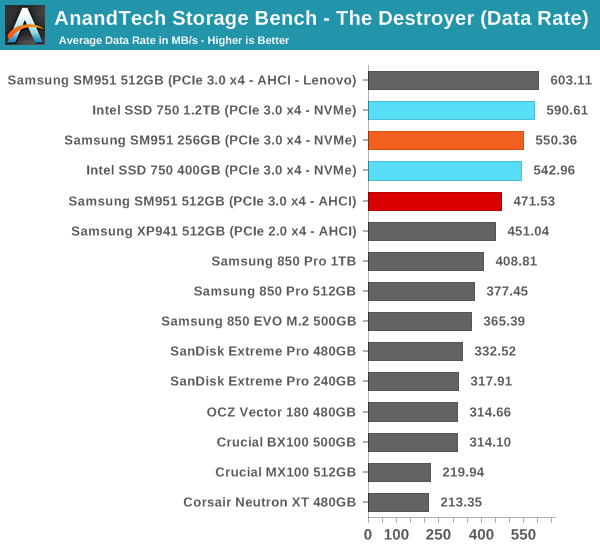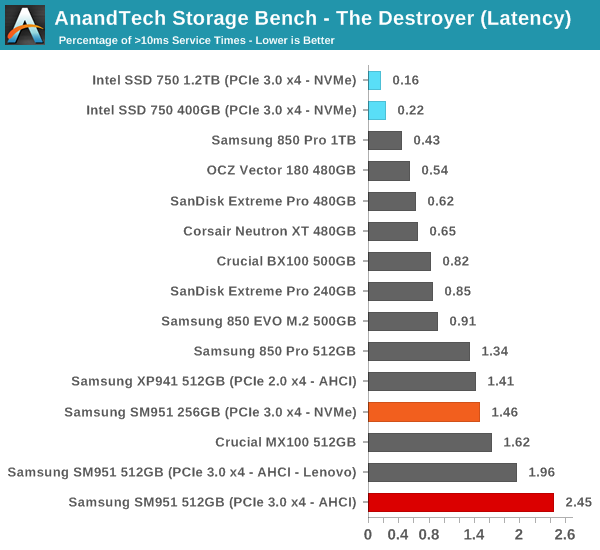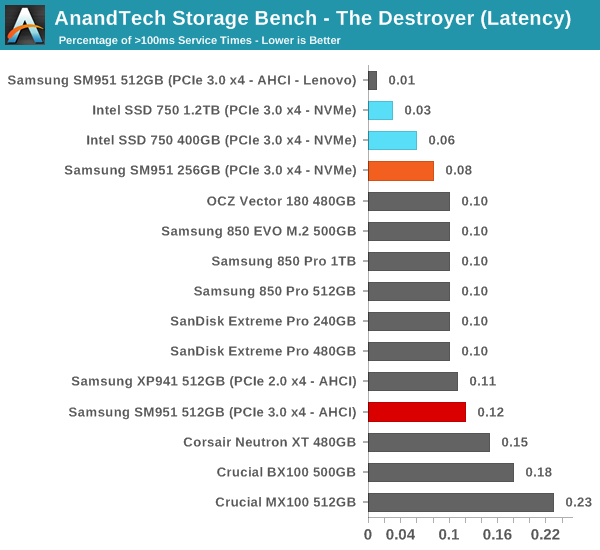Samsung SM951-NVMe (256GB) PCIe SSD Review
by Kristian Vättö on June 25, 2015 9:40 AM ESTAnandTech Storage Bench - The Destroyer
The Destroyer has been an essential part of our SSD test suite for nearly two years now. It was crafted to provide a benchmark for very IO intensive workloads, which is where you most often notice the difference between drives. It's not necessarily the most relevant test to an average user, but for anyone with a heavier IO workload The Destroyer should do a good job at characterizing performance. For full details of this test, please refer to this article.

In our The Destroyer trace, the SM951 NVMe is faster than the AHCI version despite having only half the NAND, but it still gets beaten by the SSD 750 (although the SSD 750 has more NAND as well). As I mentioned in the review, the SSD 750 has excellent small IO performance under intensive IO loads, resulting in much lower latency than what the SM951 offers, but since it performs more poorly with sequential IOs the average data rate is equivalent to the SM951 NVMe. What's surprising, though, is the fact that the SM951 AHCI that was pulled from the Lenovo laptop is in fact considerably faster than the stock SM951 we received straight from Samsung. I even ran the trace twice the ensure that it's not a benchmark anomaly, but maybe there is something wrong with my sample given that even the XP941 and several SATA 6Gbps drives outperform it.

The SM951 NVMe also has a higher share of high latency IOs than the SSD 750, but that's quite typical to smaller capacity Samsung drives.












74 Comments
View All Comments
bill.rookard - Thursday, June 25, 2015 - link
CentOS (Actually, RH6.5 and newer) are supposed to have in the box storage drivers for NVME. It apparently doesn't follow the same naming convention (/dev/sdx) since it doesn't utilize the SCSI protocols, but the NVME protocols.So - to check before you buy?
#modinfo nvme - should list if your kernel has built in nvme support.
if you have a drive in, check if an nvme drive is in there and is recognized
#lspci | grep nvme
SofS - Thursday, June 25, 2015 - link
Indeed, but my point was about their quality and how they compare between each other.der - Thursday, June 25, 2015 - link
10th comment!bernstein - Thursday, June 25, 2015 - link
i guess the 1tb 840 msata had either too slim margins or wasn't popular enough...still waiting for a 1tb M2 NVMe drive...
foxtrot1_1 - Thursday, June 25, 2015 - link
See you in December 2016, then.bernstein - Friday, June 26, 2015 - link
obviously i was wrong since there also is an 1tb msata 850 evo.... now i am very curious as to why samsung doesn't have a 1tb M2 ssd!!!Kristian Vättö - Friday, June 26, 2015 - link
Because all the PCIe drives use MLC NAND, which is a lower capacity die.kspirit - Thursday, June 25, 2015 - link
The connector looks the same as that on the old SATA SSDs found in most laptops. I've got a 2280 sized Intel 1500 SSD in my HP Folio (Haswell). Would this give me PCIe speeds?foxtrot1_1 - Thursday, June 25, 2015 - link
No.Metaluna - Thursday, June 25, 2015 - link
Depends on whether HP hooked up the PCIe lanes on their M.2 connector, which I wouldn't assume without checking into it. The BIOS also needs to have NVMe support. In the most common configurations (i.e. the "B" and "M" keyings), M.2 is required to carry both SATA and 2-4 PCIe lanes, but some motherboard vendors routinely violate this and leave out one or the other. Asus drops the SATA on some of their higher-end Z97 motherboards, for example, so you can't rule out that someone else may have made the opposite tradeoff.